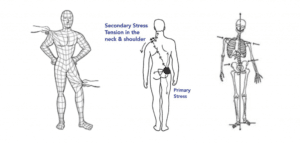What is Structural Integration?

Structural Integration (SI) is a process-based approach to somatic education, typically involving manual therapy, that explores the possibility of change in how you use and experience your body. Through education, awareness, and therapeutic touch, you can release painful, stressful patterns of tension. Effortful habits are replaced with feelings of comfort, ease of movement and posture, and a sense of whole-body coherence.
SI systematically addresses your body as a whole, usually over a series of sessions. Skillful touch brings relief from pain and discomfort, and awareness of how you’re holding and using your body. As your practitioner helps you inquire into how you relate with your body and environment, you may come to recognize patterns of tension that no longer serve you, and discover new options for movement, posture, self-care, and your overall physical experience. Rather than treating symptoms, SI practitioners work to help your body integrate internally between systems, and externally toward your life’s challenges.
Structural Integration is based on the work of Dr. Ida P. Rolf, Ph.D. SI practitioners are trained at SI schools in accordance with standards established by the International Association of Structural Integrators (IASI). Practitioners who display the Board Certified Structural Integrator (BCSI) credential have graduated from an IASI-approved training program and passed a basic competency exam.
The Benefits of Structural Integration
Our bodies grow, move, and change within the constant field of gravity; when we oppose gravity inefficiently, valuable resources are wasted. Physical injuries, trauma, and the stresses of daily life require us to adapt how we move and hold ourselves upright. These adaptive patterns can become deeply ingrained—even long after they’ve fulfilled their protective and adaptive functions—to the point that basic movements like sitting, breathing, and walking are more effortful than necessary. Such prolonged effort can contribute toward feelings of stiffness, pain, fatigue, and lack of vitality.
Structural Integration can help us learn to “let go” of chronic stress and tension, to stop fighting gravity and allow it to support us instead. Movement becomes a pleasure, breath comes easier, and “good posture” becomes effortless. We experience a sense of ease, efficiency, and grace. Many SI clients come to find relief from pain and discomfort along the way. While this describes some general benefits, the SI process is individual and personal, with a wide range of effects and benefits.
Who Benefits from SI?
All types of people benefit from Structural Integration. Some come to ease chronic pain and stress; others are hoping to improve their athletic performance; still, others are simply interested in exploring their potential for awareness and vitality. Children and older people alike can benefit from SI.
Structural Integration is contraindicated for those with infections, fevers, acute inflammation, and recent trauma. Some forms of rheumatoid arthritis, severe osteoporosis, or osteomyelitis are also contraindicated. If you are unsure whether or not SI will be safe for you, check with your doctor and inform your SI practitioner about your condition before working together.
A Typical Structural Integration Session
During the Structural Integration process, changes in your posture, movement, and physical experience are achieved through education, awareness, and therapeutic touch. The focus is on relationship—how you relate with your physical experience of yourself and your environment—rather than on any particular body part or region.
When working with a Structural Integrator for the first time, an intake process is performed, including your health and personal history, followed by an initial assessment of how you hold and move your body. Clients remain clothed to whatever extent they wish, though some kind of activewear is common. Typically, your standing posture, breath, gait (walking), and perhaps other movements are observed. Your practitioner will use that information to help design a session strategy with you, then ask you to move onto the therapy table.
While SI practitioners are often trained in “myofascial release” techniques, a range of techniques may be applied in service of the goals of the SI process. The amount of pressure used may vary greatly. A practitioner may use touch that is lighter or heavier, slow-moving or still, depending on therapeutic intent and your preferences. You may be asked to move as pressure is applied, or to stand, move around, and notice your experience during the session.
While working with your practitioner, you may experience a variety of sensations ranging from warm and pleasant to mild discomfort. Your feedback will allow your practitioner to adjust their pressure accordingly—the pace of the session is always under your control.
Structural Integrators emphasize movement education in their practices, to varying degrees. Your practitioner can help you become aware of your habitual ways of holding and moving your body and help you explore easier, more natural ways of being. Movement education might address your habits of standing posture, breathing, walking, sitting, or any specialized movements you might perform in your daily life.
Usually, Structural Integration is performed over an initial series of ten to thirteen sessions that systematically address your body as a whole, with each session building upon the previous. SI practitioners often tailor their approach to address individual needs and preferences. After your initial series, you might continue to work with your Structural Integrator to further support your goals.
a Series of 10 sessions recommended but not required. Packages available.
For your session please bring/wear sports shorts, no long sleeves shirt/or sports bra.
Brilliant Massage & Skin


